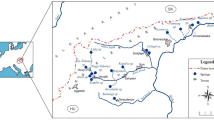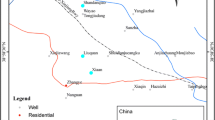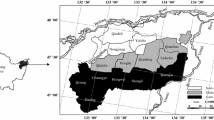Abstract
Due to the increasing high rate of economic development and population, groundwater resources of Jiansanjiang in China are affected by both anthropogenic and natural factors. In order to achieve optimal local allocation of water resources and promotion of local economic development, a suitable method for measuring the complexity of groundwater resources system is very important. In this paper, time series fractal dimension based on the curve length calculation combined with the artificial fish algorithm for the intelligent efficient fitting of data were applied to diagnose groundwater sequence in Jiansanjiang. Fractal dimension values of monthly groundwater depth series in 15 districts of Jiansanjiang Branch Bureau and their average complexity were calculated and the results revealed that the complexity of north district is the highest while that of southern district is the lowest. Our analysis also revealed that the most important influencing factor of local groundwater depth dynamics variation is the human activities and results confirmed that combined fractal theory and artificial fish algorithm for extraction hydrological time series complexity feature is feasible and can be applied in studying regional hydrological process. It also provided a scientific basis for achieving sustainable utilization of the regional groundwater resource.






Similar content being viewed by others
References
Belward JA (1999) Fractal dimensions for rainfall time series. Math Comput Simul 48(4–6):437–446
Berger T, Birner R, Díaz J et al (2007) Capturing the complexity of water uses and water users within a multi-agent framework. Water Resour Manag 21:129–148
Breslin MC, Belward JA (1999) Fractal dimensions for rainfall time series. Math Comput Simul 48(4–6):437–446
Bunde A, Havlin S (1994) Fractals in science. Springer, Berlin
Cutler CD (2000) Computing point wise fractal dimension by conditioning in multivariate distributions and time series. Bernoulli 6(3):381–399
Dean J (1998) Animates and what they can tell us. Trends Cogn Sci 2(2):60–67, M.C.Breslin
Dubovikov MM, Starchenko NV, Dubovikov MS (2004) Dimension of the minimal cover and local analysis of fractal time series. Am Phys A 339(3):591–608
Garmendia A, Salvador A (2007) Fractal dimension of birds population sizes time series. Math Biosci 206(1):155–171
Halley JM, Kunin WE (1999) Extinction risk and the 1/f family of noise models. Theor Popul Biol 56(3):215–230
Li XL, Qian JX (2003) Studies on artificial fish swarm optimization algorithm based on decomposition and coordination techniques. Chin J Semicond 8(1):1–6
Liu D, Yu M, Sun N, et al. (2011) Study on dynamic variation regularities of regional groundwater depth based on complexity diagnosis. Proceeding of The 5th International Conference on Computer and Computing Technologies in Agriculture, PartII:72–83
Ni LP (2010) Research on financial data analytical method based on fractal technology. Hefei University of Technology, Hefei
Preissl H, Lutzenberger W, Pulvermüller F et al (1999) Fractal dimensions of short EEG time series in humans. Neurosci Lett 225(2):77–80
Qu LD, He DX (2008) Bi-group artificial fish-school algorithm based on simplex method. J Comput Appl 28(8):2103–2104
Shi QH, Wang LG (2010) Simulated formula between water level and water flux based on a simplified artificial fish swarm algorithm. J Gansu Agric Univ 45(2):147–151
Suleymanov AA, Abbasov AA, Ismaylov AJ (2009a) Application of fractal analysis of time series in oil and gas production. Pet Sci Technol (27):915–922
Suleymanov AA, Abbasov AA, Ismaylov AJ (2009b) Fractal analysis of time series in oil and gas production. Chaos Solitons Fractals 41(5):2474–248
Wallis PJ, Ison RL (2011) Appreciating institutional complexity in Water Governance Dynamics: a case from the Murray-Darling Basin, Australia. Water Resour Manag 25:4081–4097
Wang XH, Zheng XM, Xiao JM (2007) Artificial Fish-Swarm Algorithm for solving constrained optimization problems. Comput Eng Appl 43(3):41–45
Wang LG, Hong Y, Zhao FQ et al (2009) Simplified artificial fish swarm algorithm. J Chin Comput Syst 30(8):1663–1667
West BJ, Zhang R, Sanders AW et al (1999) Fractal fluctuations in cardiac time series. Physica A 270(3–4):552–566
West BJ, Bologna M, Grigolini P (2003) Physics of fractal operators. Springer, New York
Wilhite DA, Svoboda MD, Hayes MJ (2007) Understanding the complex impacts of drought: a key to enhancing drought mitigation and preparedness. Water Resour Manag 21:763–774
Winz I, Brierley G, Trowsdale S (2009) The use of system dynamics simulation in water resources management. Water Resour Manag 23:1301–1323
Zhang P (2009) Nonlinear study on surrounding rock stability of Baihe Tunnel based on wavelet theory. Jilin University, Changchun
Acknowledgment
This research is supported by the National Natural Science Foundation of China No. 41071053, Postdoctoral Science Foundation of China No.20080440832, Postdoctoral Science Foundation Special Funds of China No.201003410, Specialized Research Foundation of Colleges and Universities Doctoral Program No.20102325120009, Natural Science Foundation of Heilongjiang Province No.C201026, Science and Technology Research Project of the Education Bureau in Heilongjiang Province No.11541024, Doctoral Start-up Foundation of Northeast Agricultural University No.2009RC37.
Author information
Authors and Affiliations
Corresponding authors
Rights and permissions
About this article
Cite this article
Yu, M., Liu, D. & de Dieu Bazimenyera, J. Diagnostic Complexity of Regional Groundwater Resources System Based on time series fractal dimension and Artificial Fish Swarm Algorithm. Water Resour Manage 27, 1897–1911 (2013). https://doi.org/10.1007/s11269-013-0257-8
Received:
Accepted:
Published:
Issue Date:
DOI: https://doi.org/10.1007/s11269-013-0257-8




